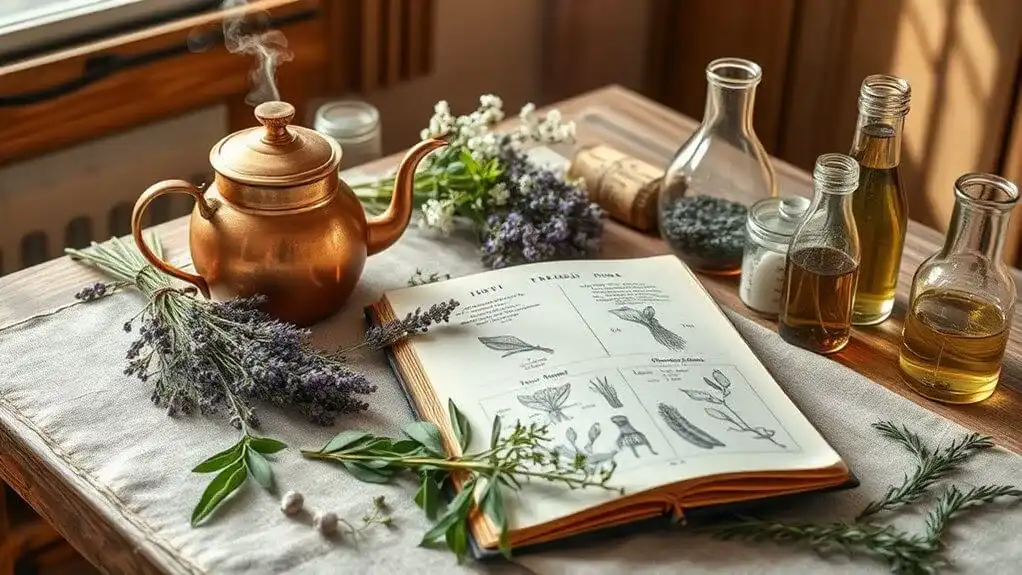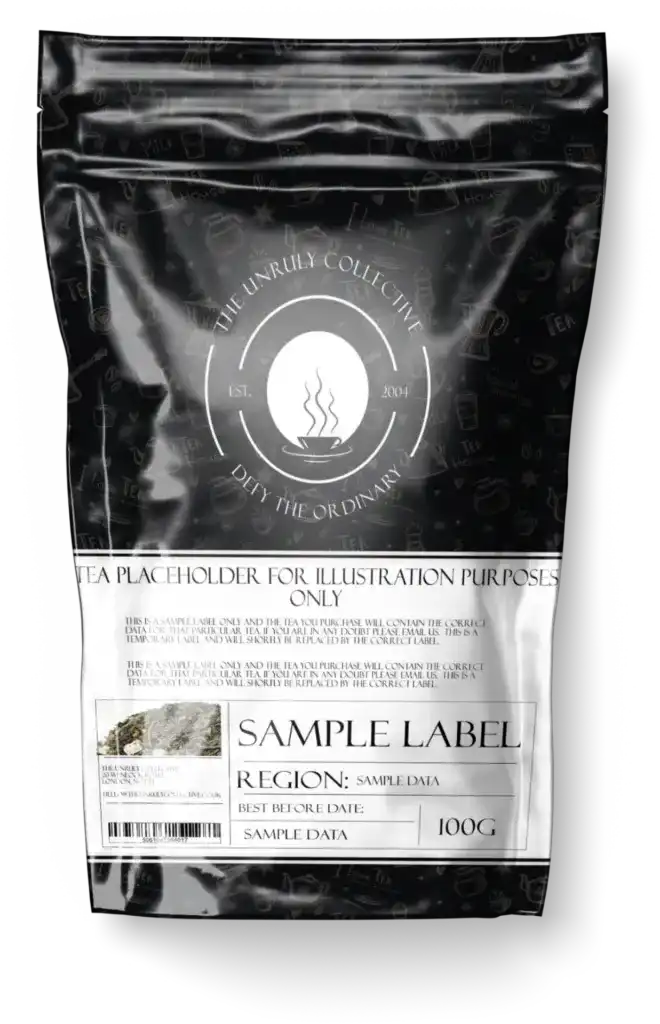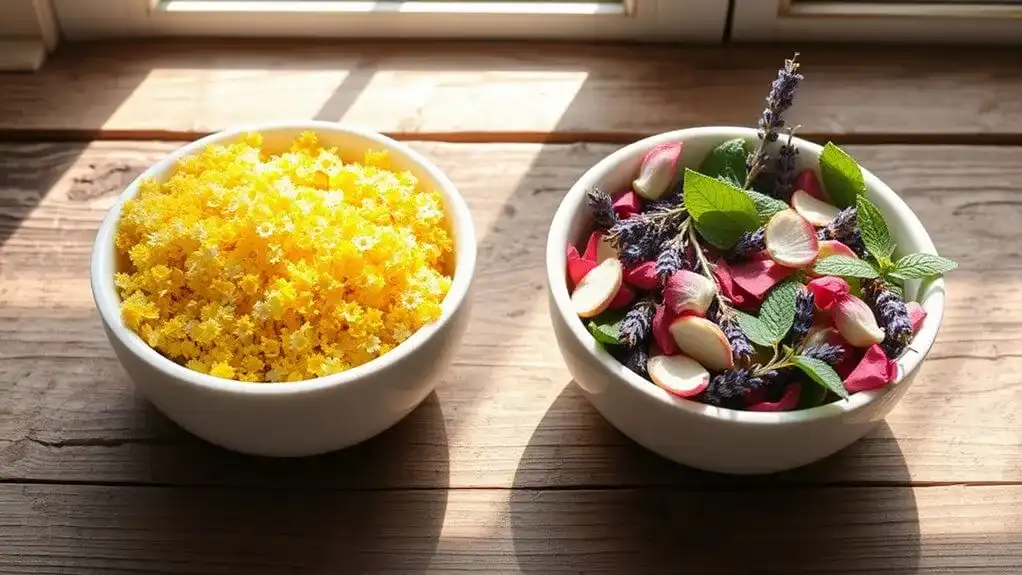European herbal tea traditions combine ancient wisdom with modern scientific validation. Dating back to Greek and Roman times, herbs like chamomile and sage have served medicinal purposes, with their properties now confirmed through advanced laboratory testing. Today's naturopathic medicine embraces these time-tested remedies, supported by a growing $6.9 billion market. While traditional harvesting methods persist, contemporary research continues to reveal the secrets behind these powerful botanical healing practices.
Key Points
- Ancient European herbalists like Hippocrates documented medicinal properties of local herbs, which modern scientific methods now validate through advanced testing.
- Traditional morning harvesting techniques preserve essential oils in herbs, a practice supported by current biochemical research.
- European Medicines Agency combines historical knowledge with modern quality standards to ensure herbal tea safety and efficacy.
- Monasteries preserved crucial herbal knowledge through medieval times, forming the foundation for today's naturopathic medicine.
- The growing global herbal tea market demonstrates how traditional remedies remain relevant in contemporary healthcare practices.
Ancient Origins of European Herbal Tea Culture
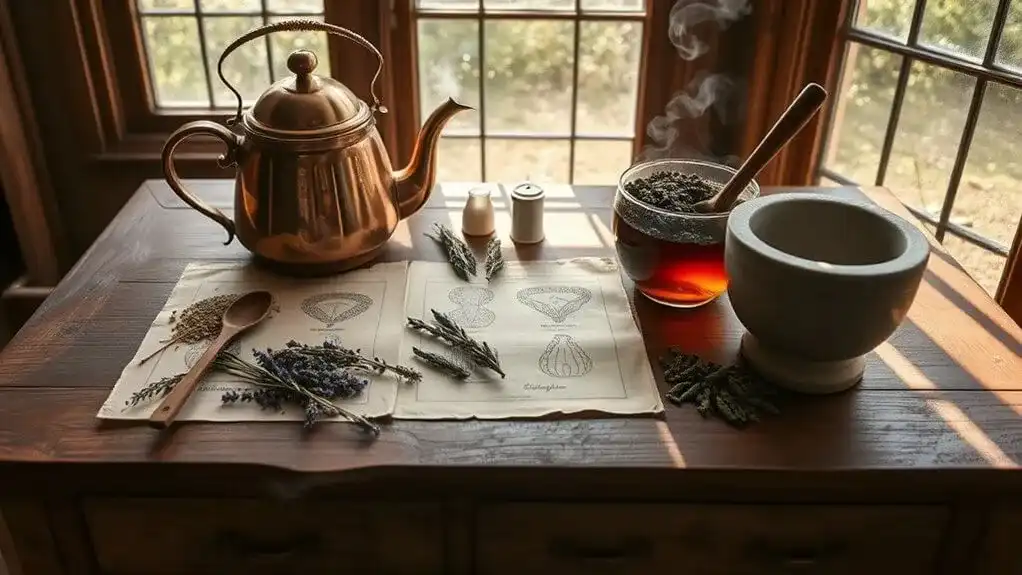
While tea's global journey began in ancient China during the Shang dynasty, Europe's relationship with herbal tea developed through distinct cultural paths. The Greeks and Romans pioneered ancient practices that incorporated local herbs like chamomile and sage for medicinal purposes. These herbal folklore traditions gained credibility through scholars like Hippocrates, who documented their therapeutic properties. As Dutch East India Company merchants brought the first shipments of green tea to Amsterdam in the early 1600s, they encountered a well-established herbal tea culture. While Asians initially doubted tea's effectiveness for European constitutions, the continent's populations had already mastered their own healing brews. Medieval monasteries became vital centers for preserving and advancing herbal knowledge throughout Europe. Greeks found their ideal climate particularly suitable for cultivating a wide variety of medicinal herbs. This fusion of Eastern and Western botanical knowledge enriched Europe's existing herbal traditions, leading to a diverse tapestry of medicinal tea practices that combined local wisdom with new discoveries.
Traditional Harvesting Methods and Sacred Rituals
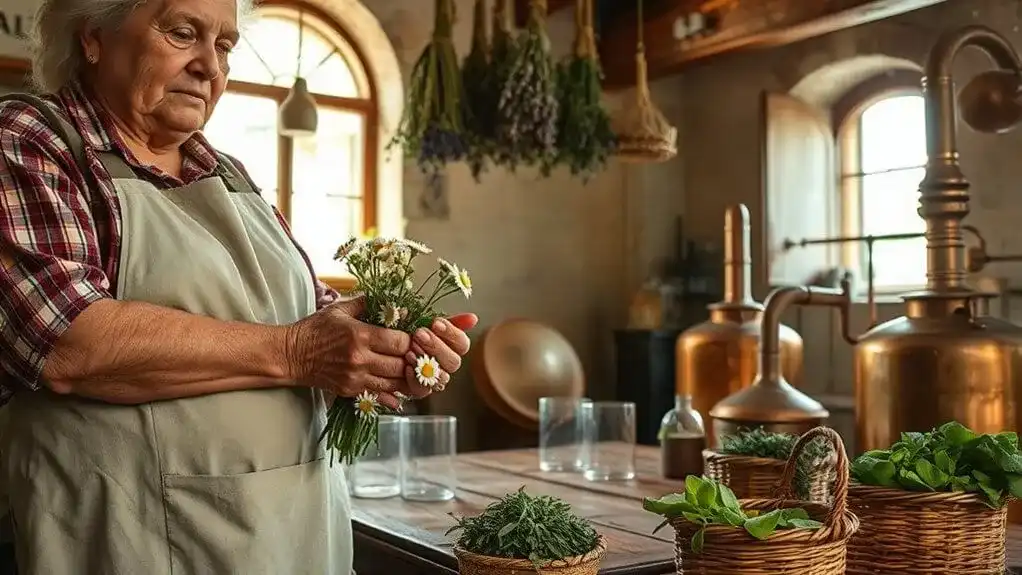
Three key elements define traditional herbal tea harvesting: precise timing, sacred intention, and proper technique. Traditional harvesting techniques emphasize gathering herbs in the morning after dew evaporates but before the day's heat depletes plant oils. Each herb demands specific attention – calendula blossoms must be picked before seeding, while lemon grass requires pulling from the base. Simple food dehydrators provide optimal results when drying herbs in humid European regions. Many practitioners store their harvested herbs in airtight containers to maintain freshness and potency. Ancient herbalists recognized that herbs displayed varying personalities throughout different seasons, influencing their potency and use.
The ritual significance of herbal tea preparation extends beyond mere harvesting. Traditional European herbalists create sacred spaces using symbolic items like circular trays and ritual teapots, representing elements and the Tree of Life. They invoke ancient wisdom through blessings and intentions, preparing tea and water a day before ceremonies. This practice reflects the deeper cultural understanding of herbs' energetic patterns and planetary associations, embedding harvesting within a broader spiritual framework that honors both plant and practitioner.
Scientific Validation of Historical Remedies
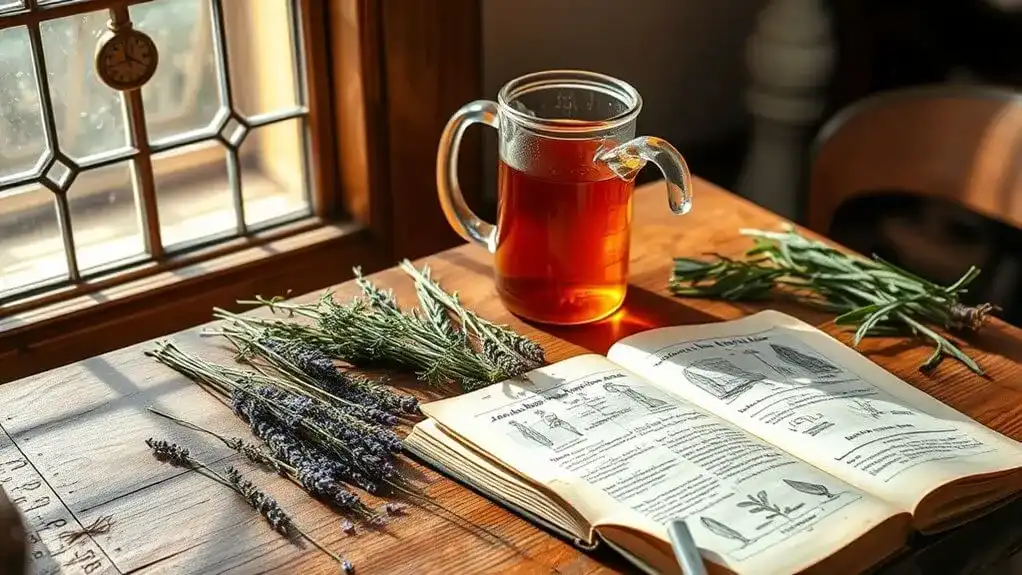
Modern scientific validation of herbal tea remedies has transformed traditional knowledge into standardized, evidence-based treatments. Through rigorous scientific methodologies, researchers now employ sophisticated testing procedures like chromatography and marker substance analysis to verify the therapeutic properties of traditional herbal teas.
Quality assurance measures have become increasingly stringent, with the European Medicines Agency establishing thorough guidelines for testing herbal products. These include mandatory checks for contaminants, stability testing, and quantitative determination of active compounds. The European Pharmacopoeia's monographs serve as essential reference points, ensuring that traditional remedies meet modern safety and efficacy standards. This systematic approach combines centuries-old wisdom with contemporary analytical techniques, validating the therapeutic claims of herbal teas through demonstrable scientific evidence rather than relying solely on historical usage patterns. Manufacturers must submit a full quality dossier to meet regulatory requirements before bringing any herbal medicinal product to market in the EU.
Modern Applications in Naturopathic Medicine
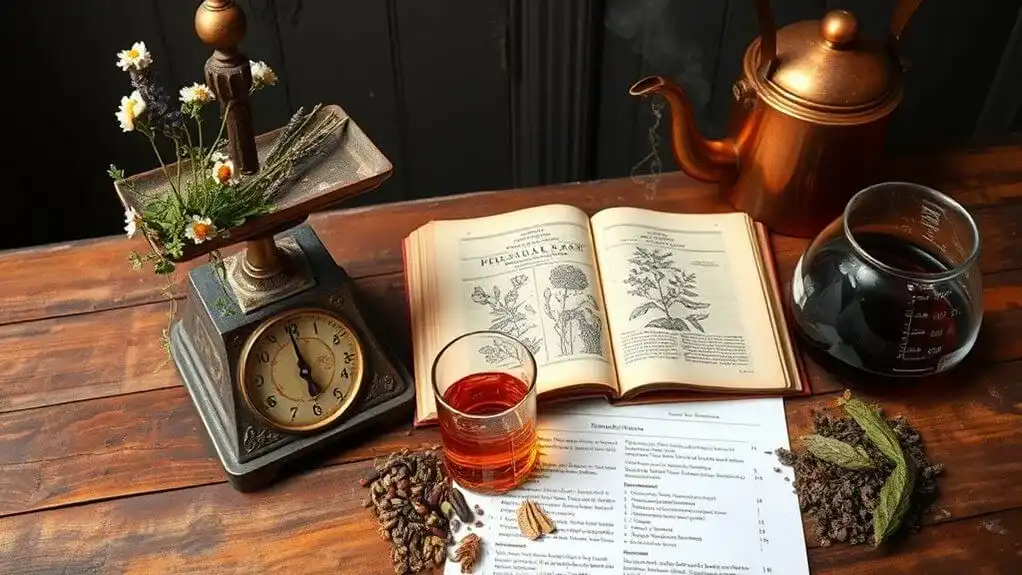
Naturopathic medicine has embraced herbal teas as cornerstone treatments, integrating traditional knowledge with contemporary market demands. The global herbal tea market reflects this trend, projected to reach $6.9 billion by 2032, with chamomile leading at 34% market share. Modern herbal tea blends incorporate ingredients from diverse plant families like Rosaceae and Asteraceae, often featuring up to 40 components for preventive health care.
Consumer trends show a strong preference for natural products, with over 66% of buyers willing to pay premium prices for organic options. While these remedies draw from ancient European traditions, they're now being examined through new pharmacological approaches to understand their biological effects. China dominates the export market at 25.41%, while regional variations in formulations continue to reflect distinct cultural healing practices.
Sustainable Practices and Cultural Preservation
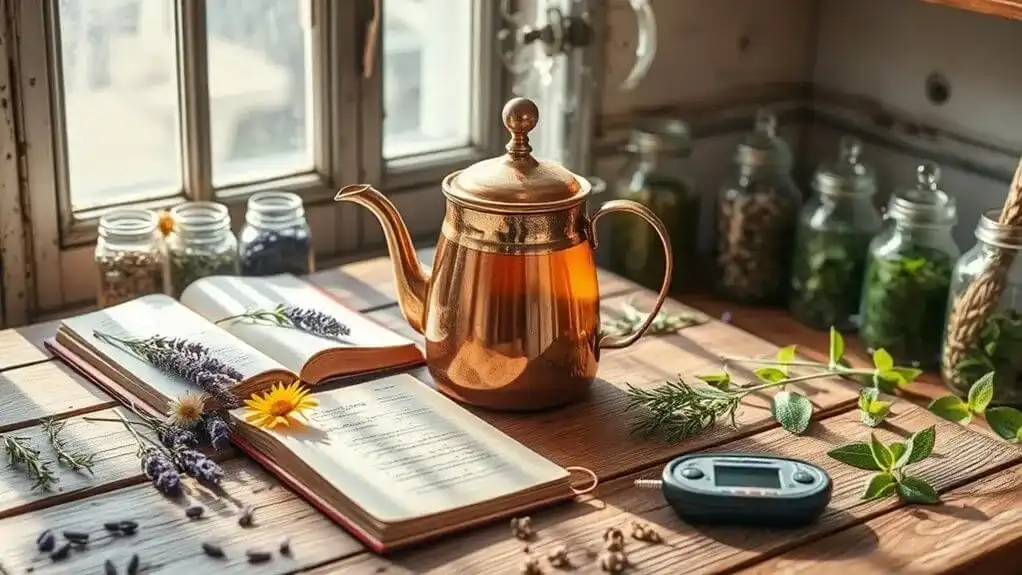
While sustainable practices have become increasingly vital in herbal tea production, they're now deeply intertwined with cultural preservation efforts. Sustainable sourcing through direct trade relationships guarantees farmers maintain traditional cultivation methods while receiving fair compensation. This approach protects both ancient farming techniques and local ecosystems.
Organic certifications like Soil Association and Rainforest Alliance play an important role in preserving cultural heritage. These standards encourage farmers to use time-honored organic practices that date back thousands of years, particularly in Asian cultures where tea making remains a revered art. The guidelines align with historical texts like The Ch'a Ching, which emphasizes proper cultivation techniques and ceremonial aspects. This marriage of sustainability and tradition helps protect biodiversity while keeping ancient tea-making customs alive for future generations. Heavy pesticide use in conventional tea farming has made these organic certifications increasingly crucial for environmental protection. With over 350 varieties in their collection, companies like Ronnefeldt demonstrate how traditional cultivation methods can support a diverse and sustainable tea culture.
Conclusion
Like an ancient manuscript being carefully translated into modern language, Europe's herbal tea traditions continue bridging past and present. Scientists have validated what village healers knew centuries ago – chamomile really does contain apigenin, which reduces anxiety. Today's renewed interest in natural remedies has created a $3.8 billion herbal tea market, proving that these time-tested botanical remedies aren't just steeped in history – they're flourishing in modern times.
